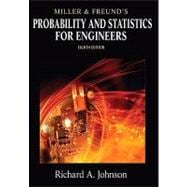
Note: Supplemental materials are not guaranteed with Rental or Used book purchases.
Purchase Benefits
Richard Johnson is the co-author of seven statistics texts and monographs, including Probability and Statistics for Engineers and Applied Multivariate Statistical Analysis. He was thefounding editor of Statistics and Probability Letters and served as editor for 25 years.Besides many years of experience in teaching all levels of statistics courses at the University of Wisconsin, he has published more than 120 technical papers concentrating in the areas of reliability and life testing, multivariate analysis, large sample theory, and applications to engineering. Johnson has presented talks on his research in 23 foreign counties. He is an elected member of the International Statistical Institute, a Fellow of the American Statistical Association, a Fellow of theInstitute of Mathematical Statistics, and a Fellow of the Royal Statistical Society.
Preface
1. Introduction
1.1 Why Study Statistics?
1.2 Modern Statistics
1.3 Statistics and Engineering
1.4 The Role of the Scientist and Engineer in Quality Improvement
1.5 A Case Study: Visually Inspecting Data to Improve Product Quality
1.6 Two Basic Concepts–Population and Sample
2. Organization and Description of Data
2.1 Pareto Diagrams and Dot Diagrams
2.2 Frequency Distributions
2.3 Graphs of Frequency Distributions
2.4 Stem-and-Leaf Displays
2.5 Descriptive Measures
2.6 Quartiles and Percentiles
2.7 The Calculation of x and s
2.8 A Case Study: Problems with Aggregating Data
3. Probability
3.1 Sample Spaces and Events
3.2 Counting
3.3 Probability
3.4 The Axioms of Probability
3.5 Some Elementary Theorems
3.6 Conditional Probability
3.7 Bayes’ Theorem
4. Probability Distributions
4.1 Random Variables
4.2 The Binomial Distribution
4.3 The Hypergeometric Distribution
4.4 The Mean and the Variance of a Probability Distribution
4.5 Chebyshev’s Theorem
4.6 The Poisson Approximation to the Binomial Distribution
4.7 Poisson Processes
4.8 The Geometric and Negative Binomial Distribution
4.9 The Multinomial Distribution
4.10 Simulation
5. Probability Densities
5.1 Continuous Random Variables
5.2 The Normal Distribution
5.3 The Normal Approximation to the Binomial Distribution
5.4 Other Probability Densities
5.5 The Uniform Distribution
5.6 The Log-Normal Distribution
5.7 The Gamma Distribution
5.8 The Beta Distribution
5.9 The Weibull Distribution
5.10 Joint Distributions–Discrete and Continuous
5.11 Moment Generating Functions
5.12 Checking If the Data Are Normal
5.13 Transforming Observations to Near Normality
5.14 Simulation
6. Sampling Distributions
6.1 Populations and Samples
6.2 The Sampling Distribution of the Mean (σ known)
6.3 The Sampling Distribution of the Mean (σ unknown)
6.4 The Sampling Distribution of the Variance
6.5 Representations of the Normal Theory Distributions
6.6 The Moment Generating Function Method to Obtain Distributions
6.7 Transformation Methods to Obtain Distributions
7. Inferences Concerning a Mean
7.1 Point Estimation
7.2 Interval Estimation
7.3 Maximum Likelihood Estimation
7.4 Tests of Hypotheses
7.5 Null Hypotheses and Tests of Hypotheses
7.6 Hypotheses Concerning One Mean
7.7 The Relation between Tests and Confidence Intervals
7.8 Power, Sample Size, and Operating Characteristic Curves
8. Comparing Two Treatments
8.1 Experimental Designs for Comparing Two Treatments
8.2 Comparisons–Two Independent Large Samples
8.3 Comparisons–Two Independent Small Samples
8.4 Matched Pairs Comparisons
8.5 Design Issues–Randomization and Pairing
9. Inferences Concerning Variances
9.1 The Estimation of Variances
9.2 Hypotheses Concerning One Variance
9.3 Hypotheses Concerning Two Variances
10. Inferences Concerning Proportions
10.1 Estimation of Proportions
10.2 Hypotheses Concerning One Proportion
10.3 Hypotheses Concerning Several Proportions
10.4 Analysis of r x c Tables
10.5 Goodness of Fit
11. Regression Analysis
11.1 The Method of Least Squares
11.2 Inferences Based on the Least Squares Estimators
11.3 Curvilinear Regression
11.4 Multiple Regression
11.5 Checking the Adequacy of the Model
11.6 Correlation
11.7 Multiple Linear Regression (Matrix Notation)
12. Analysis of Variance
12.1 Some General Principles
12.2 Completely Randomized Designs
12.3 Randomized-Block Designs
12.4 Multiple Comparisons
12.5 Analysis of Covariance
13. Factorial Experimentation
13.1 Two-Factor Experiments
13.2 Multifactor Experiments
13.3 2 n Factorial Experiments
13.4 The Graphic Presentation of 22 and 23 Experiments
13.5 Response Surface Analysis
13.6 Confounding in a 2 n Factorial Experiment
13.7 Fractional Replication
14. Nonparametric Tests
14.1 Introduction
14.2 The Sign Test
14.3 Rank-Sum Tests
14.4 Correlation Based on Ranks
14.5 Tests of Randomness
14.6 The Kolmogorov-Smirnov and Anderson-Darling Tests
15. The Statistical Content of Quality-Improvement Programs
15.1 Quality-Improvement Programs
15.2 Starting a Quality-Improvement Program
15.3 Experimental Designs for Quality
15.4 Quality Control
15.5 Control Charts for Measurements
15.6 Control Charts for Attributes
15.7 Tolerance Limits
16. Application to Reliability and Life Testing
16.1 Reliability
16.2 Failure-Time Distribution
16.3 The Exponential Model in Life Testing
16.4 The Weibull Model in Life Testing
Appendix A Bibliography
Appendix B Statistical Tables
Appendix C Using the R Software Program
Appendix D Answers to Odd-Numbered Exercises
The New copy of this book will include any supplemental materials advertised. Please check the title of the book to determine if it should include any access cards, study guides, lab manuals, CDs, etc.
The Used, Rental and eBook copies of this book are not guaranteed to include any supplemental materials. Typically, only the book itself is included. This is true even if the title states it includes any access cards, study guides, lab manuals, CDs, etc.